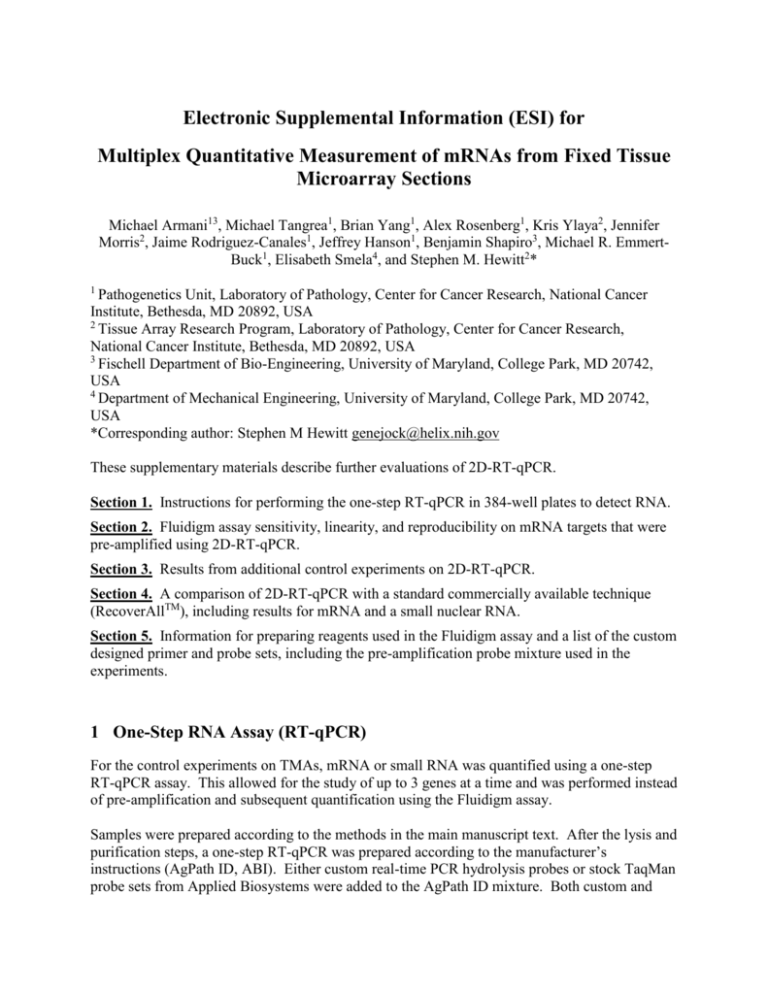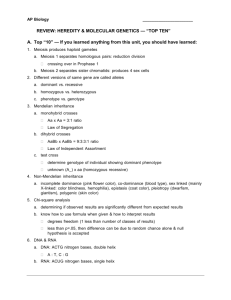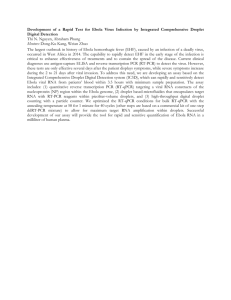1 One-Step RNA Assay (RT
advertisement

Electronic Supplemental Information (ESI) for Multiplex Quantitative Measurement of mRNAs from Fixed Tissue Microarray Sections Michael Armani13, Michael Tangrea1, Brian Yang1, Alex Rosenberg1, Kris Ylaya2, Jennifer Morris2, Jaime Rodriguez-Canales1, Jeffrey Hanson1, Benjamin Shapiro3, Michael R. EmmertBuck1, Elisabeth Smela4, and Stephen M. Hewitt2* 1 Pathogenetics Unit, Laboratory of Pathology, Center for Cancer Research, National Cancer Institute, Bethesda, MD 20892, USA 2 Tissue Array Research Program, Laboratory of Pathology, Center for Cancer Research, National Cancer Institute, Bethesda, MD 20892, USA 3 Fischell Department of Bio-Engineering, University of Maryland, College Park, MD 20742, USA 4 Department of Mechanical Engineering, University of Maryland, College Park, MD 20742, USA *Corresponding author: Stephen M Hewitt genejock@helix.nih.gov These supplementary materials describe further evaluations of 2D-RT-qPCR. Section 1. Instructions for performing the one-step RT-qPCR in 384-well plates to detect RNA. Section 2. Fluidigm assay sensitivity, linearity, and reproducibility on mRNA targets that were pre-amplified using 2D-RT-qPCR. Section 3. Results from additional control experiments on 2D-RT-qPCR. Section 4. A comparison of 2D-RT-qPCR with a standard commercially available technique (RecoverAllTM), including results for mRNA and a small nuclear RNA. Section 5. Information for preparing reagents used in the Fluidigm assay and a list of the custom designed primer and probe sets, including the pre-amplification probe mixture used in the experiments. 1 One-Step RNA Assay (RT-qPCR) For the control experiments on TMAs, mRNA or small RNA was quantified using a one-step RT-qPCR assay. This allowed for the study of up to 3 genes at a time and was performed instead of pre-amplification and subsequent quantification using the Fluidigm assay. Samples were prepared according to the methods in the main manuscript text. After the lysis and purification steps, a one-step RT-qPCR was prepared according to the manufacturer’s instructions (AgPath ID, ABI). Either custom real-time PCR hydrolysis probes or stock TaqMan probe sets from Applied Biosystems were added to the AgPath ID mixture. Both custom and stock primer/probe sets were mixed to a final concentration of 225 nM (primers) and 62.5 nM (probe). The PCR reagents containing the diluted probe sets were added to the 384-well plates containing purified RNA, which was amplified according to the manufacturer’s protocol. RTqPCR curves were measured using a fluorescent plate reader every 3 to 5 cycles, and Cts were calculated as described previously 1. 2 Assay Sensitivity, Linearity, and Reproducibility As described in the main text, positive control mRNA and negative controls (water) underwent the same reverse transcription and pre-amplification protocol that was applied to the mRNA isolated from the prostate TMA cores. Specifically, 1 L of commercially-purified human total RNA at 4 different concentrations in water (1000 ng, 125 ng, 15.6 ng, and 1.95 ng) and a negative control (water) were added to 5 adjacent empty wells and processed as described in the Methods section of the main text. Using the Cts measured for the control RNA, the assay detection limit was determined to be as low as 1.95 ng for all the targets with the exception of HPRT1, a low-abundance target that had a detection limit of 15.6 ng. Only one false positive (TIMP3) was detected among the negative controls, and it was detected at 26.1 Cts, well outside the range of 15.7 to 21 Cts for the prostate samples that were run in parallel. The control RNA dilution series showed the Pearson r² linearity of the assay (Cts versus ng) that was calculated for each probe set varied from 0.9976 to 0.999, exceeding the performance specifications described by the manufacturers of TaqMan probe sets. The samples were also assayed for each target in duplicate to allow us to calculate the reproducibility of the Fluidigm system. The reproducibility for each target (n = 2) was first calculated by the standard deviation. However, since the standard deviation from only two samples would provide large bias, we define here the “aggregate variability,” which is the average of standard deviations across Cts from all tissue samples (n <= 42) for each target probe set. This measurement is important because it indirectly estimates the combined experimental bias, including the pre-amplification step, randomness in primer-target annealing, error in fluorescent detection using the Fluidigm hardware and software, and variability of PCR across the high dynamic range of samples prepared by 2D-RT-qPCR. The aggregate variability ranged from 0.06 to 0.49 Cts with a median value of 0.19. The variability of the Fluidigm system had been previously reported to range from 7% for highly abundant targets to 46% for targets with 10 copies 2. To compare these numbers to our results we converted the measurement from Cts (0.06 to 0.49) to percent change (4.2% to 40.4%) using the formula percent change = 100% · (1 - 2Cts). Based on this calculation, our results for the performance of the Fluidigm systems are similar to those previously published. In addition, the lowest aggregate variability came from a high-abundance target (CYPA, mean 18.0 Cts, variability = 0.06 Cts), while the highest variability came from a low-abundance target, (HPRT1, mean 24.4 Cts, variability = 0.49 Cts). Therefore, the performance of 2D-RT-qPCR when applied to TMA tissues in combination with the Fluidigm assay also shows similar performance to that reported for the Fluidigm system alone. 3 Additional Control Experiments Multiple TMAs were constructed, including mouse and human tissue cores. Evaluation of these TMAs by 2D-RT-qPCR demonstrated that decalcified specimens as well as some archival specimens were inadequate for evaluation due to degradation of biomolecules 3. Assay specificity was tested with human specific probes against a mouse tissue cores and the converse of mouse specific probes against human tissue. No cross-species transcripts were identified, while all controls performed as specified. To ascertain the specificity and dynamic range of 2DRT-qPCR in a multiplexed reaction, three mRNA targets (KCNJ1, GYS2, and HPRT1) were coamplified from mRNA isolated from FFPE mouse tissues, showing target tissue specificity (GYS2 for liver and KCNJ1 for kidney) and a wide dynamic range in qPCR signals (over 14 Cts). 4 Comparison of 2D-RT-qPCR with Commercial Techniques Initially, a TMA was run through the 2D-RT-qPCR protocol without the use of the Fluidigm system to determine the minimum required tissue core size for sufficient RNA recovery. This was performed on a TMA containing human liver cores with a range of diameters from 0.6 to 2.0 millimeters. The TMA contained 24 cores with 6 replicates over 4 core sizes. To assess different RNA target types, the levels of RNU48, a highly abundant small nucleolar RNA, and SOD2 mRNA were quantified by multiplex RT-qPCR. The procedure was also repeated and compared against a more common workflow that included the commercially available RecoverAll kit (Invitrogen) to obtain total RNA. As recommended by the manufacturer, RNA was quantified with a two-step procedure of reverse transcription and then real-time qPCR. The 2D-RT-qPCR workflow followed the steps described in the main text and in Section 1 above. To perform the RecoverAll workflow, a 10 m section of the TMA was placed on a glass slide and deparaffinized. All 24 cores were macrodissected off of the slide and into a 1.5 mL tube using a razor blade. The RecoverAll procedure was followed as described by the manufacturer, and qPCR assays were performed. 40 RA, SOD2 Cts 35 RA, RNU48 30 2D, SOD2 25 2D, RNU48 20 0.5 1.0 1.5 2.0 Core Size (mm) Figure 1. Comparison of RecoverAll (RA, green and black points) and 2D-RT-qPCR (2D, red and blue points) for the recovery and detection of mRNA (SOD2) or small nuclear RNA (RNU48). Points show the experimental data while lines indicate theoretical values assuming 100% PCR efficiency and accounting for the difference in starting material based on core size. Figure 1 shows the Cts of detection for the two types of RNA versus core diameter. Using 2DRT-qPCR, both mRNA (red points) and small RNA (blue points) were detected from cores with sizes as small as 0.6 mm. The required Cts were higher for smaller cores, as expected, the number following the theoretical curves for both types of RNA. The theoretical curve is a doubling of template every cycle during the exponential growth phase of PCR. The RecoverAll procedure allowed for detection of the highly abundant RNU48, but there was a poor correlation with core diameter (black points in Figure 1), and detection came approximately 10 cycles later than with 2D-RT-qPCR. RecoverAll did not result in detection of SOD2 mRNA (green points); the cycling was stopped at 40 cycles. The difference in results obtained with the RecoverAll protocol suggests differential recovery and/or amplification of mRNA damaged during the formalin fixation and storage process 4. In addition, the concentration of RNA purified with 2D-RT-qPCR was initially higher because it was concentrated on the surface of beads, whereas the RecoverAll system requires dilution of the purified mRNA. In other words, the entirety of the mRNA recovered by 2D-RT-qPCR can be used during PCR, whereas with RecoverAll, it is impractical to use more than a small volume of the recovered sample. 5 Fluidigm Assay To perform a Fluidigm assay, 24 TaqMan probe sets (in duplicate) were mixed with Fluidigm loading buffer, and a custom made PCR mix was added to the assay wells of a 48x48 Fluidigm plate. The PCR mix consisted of 30 mM KCl, 25 mM Tris, 3 mM MgCl2, 1 mM dithiothreitol, 0.4 mM dNTPs (New England Biolabs), and 0.04 Units/µL Dynazyme II DNA polymerase. Then, 48 pre-amplified samples were mixed with Fluidigm loading buffer and added to the sample wells of the 48x48 Fluidigm plate, and the plate was run according to the Fluidigm protocol. The samples included 24 prostate tumors, 18 normal prostates, a dilution series of 4 samples, 1 negative control, and one blank well. 24 primers were used in the pre-amplification protocol and are shown in the table below. The pre-amplification mixture contained TaqMan primer/probe sets (those with an Applied Biosystems ID starting with “Hs”) that were diluted 450-fold in the final pre-amplification mixture, providing 40 nM of each primer, along with PCR probes that were diluted to below detectable levels (11.1 nM each) and did not affect subsequent qPCR detection. The custom primer/probe sets (B2M and GUS) were also diluted to a final concentration of 40 nM per primer. Table 1. Custom and TaqMan probe sets used Applied Biosystems ID Gene Description Included in Analysis? Hs00260717_m1 AKT AKT1 substrate 1 (proline-rich) No – primer/probe set failed to show any amplification. Hs00233455_m1 ALCAM activated leukocyte cell adhesion molecule Yes Hs01091294_m1 AMACR alpha-methylacyl-CoA racemase Yes Hs00265741_s1 ANG angiogenin, ribonuclease, RNase A family, 5 Yes Hs00171172_m1 AR androgen receptor Yes Hs00156399_m1 CD69 CD69 molecule Yes Hs00379515_m1 FOLH1 folate hydrolase (prostate-specific membrane antigen) 1 Yes Hs02512067_s1 GSTP1 glutathione S-transferase pi 1 Yes Hs00153153_m1 H1F1A hypoxia inducible factor 1, alpha subunit Yes Hs00233820_m1 JAK1 Janus kinase 1 Yes Hs00153510_m1 MME/CD10 membrane metallo-endopeptidase Yes Hs00410317_m1 MUC1 mucin 1, cell surface associated Yes Hs00167309_m1 SOD2 superoxide dismutase 2, mitochondrial Yes Hs00560035_m1 STAT5 signal transducer and activator of transcription 5B Yes Hs00158980_m1 TACSTD1 EPCAM (epithelial cell adhesion molecule) Hs00927216_m1 TIMP3 TIMP metallopeptidase inhibitor 3 Yes Yes - one false positive in the control resulted in us choosing a a cutoff threshold of 26 Cts. Hs00173626_m1 VEGF vascular endothelial growth factor Yes Hs00184451_m1 VHL Von Hippel–Lindau tumor suppressor 4326315E ACTB (endogenous control) housekeeping gene Yes No – “endogenous” primers provided by Applied Biosystems were too dilute to provide efficient amplification. 4333763 CYPA housekeeping gene Yes 4333764 GAPDH housekeeping gene Yes Hs99999909_m1 See B2M forward, reverse, and probe sequences below. HPRT1 housekeeping gene Yes B2M - custom ordered housekeeping gene Yes See GUS forward, reverse, and probe sequences below. GUS - custom ordered housekeeping gene Yes mRNA Primer Sets (Biosearch Technologies) Target Forward (5’ to 3’) Reverse (5’ to 3’) Mouse Liver GYS2 GCCAGACACCTGACACTGA TCCGTCGTTGGTGGTGATG Mouse Kidney KCNJ1 GGCGGGAAGACTCTGGTTA GTGCCAGGAACCAAACCTA Mouse Control HPRT1 GCAAACTTTGCTTTCCCTGG ACTTCGAGAGGTCCTTTTCACC GUSB GGCCGCTGTGGGAGTCAG GATGTCATTGAAGCTGGAGGGAAC B2M TCTTTCTGGCCTGGAGGCTA CCATTCTCTGCTGGATGACG Target Probe (5’ to 3’) Mouse Liver GYS2 5'CalFluorOrange560-TTTCCAGACAAATTCCACCTAGAGCCC-BHQ1 Mouse Kidney KCNJ1 5-FAM-AAGCACCGTGGCTGATCTTCCAGA-BHQ1 Mouse Control HPRT1 5'Quasar670-CAGCCCCAAAATGGTTAAGGTTGCAAG-BHQ2 GUS Probe* 5'CalFluorOrange560-CCCCACCGTGGACATGCCA-BHQ1 B2M Probe* 5'CalFluorOrange560-TCCAGCGTACTCCAAAGATTCAGG-BHQ1 *CAL Fluor Orange 560 - detected using VIC reporter on Fluidigm Small RNA Primer Sets (Biosearch Technologies) Target Forward (5’ to 3’) Reverse (5’ to 3’) Human RNU48 ATGACCCCAGGTAACTCTGA GAGCGCTGCGGTGAT Target Human RNU48 Probe (5’ to 3’) 5'Quasar670-TGTGTCGCTGATGCC-BHQ2 6 References 1. Armani M, Tangrea M, Shapiro B, et al. Quantifying mRNA levels across tissue sections with 2D-RT-qPCR. Anal Bioanal Chem. 2011;400:3383-3393. 2. Devonshire A, Elaswarapu R, Foy C. Applicability of RNA standards for evaluating RT-qPCR assays and platforms. BMC Genomics. 2011;12:118. 3. Hewitt S, Lewis F, Cao Y, et al. Tissue handling and specimen preparation in surgical pathology. Arch Pathol Lab Med. 2008;132:1929-1935. 4. Masuda N, Ohnishi T, Kawamoto S, et al. Analysis of chemical modification of RNA from formalin-fixed samples and optimization of molecular biology applications for such samples. Nucleic Acids Res. 1999;27:4436-4443.






